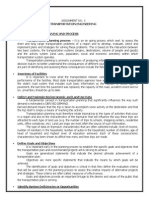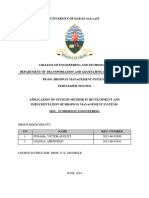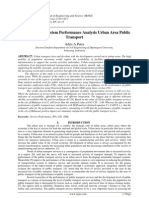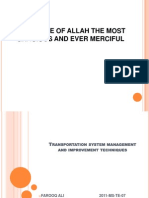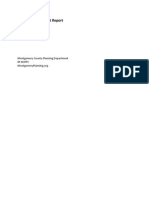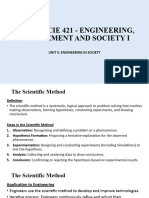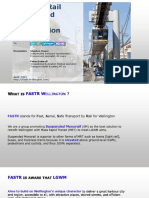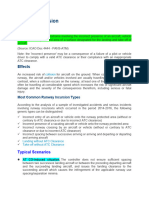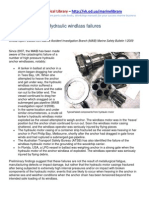0 ratings0% found this document useful (0 votes)
16 viewsLecture 6. Asset Management
Lecture 6. Asset Management
Uploaded by
Respicus RJThe document discusses transportation planning and engineering. It covers topics like road asset management, requirements from stakeholders, capturing usage and condition data, and evaluating asset condition. Maintaining infrastructure, safety, and reliability are important goals.
Copyright:
© All Rights Reserved
Available Formats
Download as PDF, TXT or read online from Scribd
Lecture 6. Asset Management
Lecture 6. Asset Management
Uploaded by
Respicus RJ0 ratings0% found this document useful (0 votes)
16 views45 pagesThe document discusses transportation planning and engineering. It covers topics like road asset management, requirements from stakeholders, capturing usage and condition data, and evaluating asset condition. Maintaining infrastructure, safety, and reliability are important goals.
Original Title
Lecture 6. Asset Management
Copyright
© © All Rights Reserved
Available Formats
PDF, TXT or read online from Scribd
Share this document
Did you find this document useful?
Is this content inappropriate?
The document discusses transportation planning and engineering. It covers topics like road asset management, requirements from stakeholders, capturing usage and condition data, and evaluating asset condition. Maintaining infrastructure, safety, and reliability are important goals.
Copyright:
© All Rights Reserved
Available Formats
Download as PDF, TXT or read online from Scribd
Download as pdf or txt
0 ratings0% found this document useful (0 votes)
16 views45 pagesLecture 6. Asset Management
Lecture 6. Asset Management
Uploaded by
Respicus RJThe document discusses transportation planning and engineering. It covers topics like road asset management, requirements from stakeholders, capturing usage and condition data, and evaluating asset condition. Maintaining infrastructure, safety, and reliability are important goals.
Copyright:
© All Rights Reserved
Available Formats
Download as PDF, TXT or read online from Scribd
Download as pdf or txt
You are on page 1of 45
Mulungushi University
Department of Engineering
CIE 462 – Transportation Planning & ENGINEERING
(Pre-requisite – CIE 435 – HIGHWAY ENGINEERING)
FIFTH Year 1st Semester– Civil
Engineering
Lecturer: Frank Mwangilwa
BEng (Civil), MSc Eng. (Struct), MSc. (Arch. & Civ), MEIZ, R.Eng.
Road authorities have an obligation to plan, design, construct and
maintain the road network, to protect the public investment in the
road infrastructure, to ensure the continued functionality of the
transportation system and to promote the safety of traffic on the
road network. \
Authorities also have the obligation to provide a reliable, effective,
efficient and integrated transport system that supports the
sustainable economic and social development of the country
A Road Asset Management System involves an all-encompassing
systems approach to road infrastructure asset management.
“Worst First” Approach
Pavement Management approach
Zambian roads are normally very sensitive to moisture ingress,
preventive maintenance is regarded as being of utmost importance in
order to retard deterioration and preserve asset values. Road users and
other stakeholders are normally unaware of these preventive needs and
related activities and are more concerned with factors that influence
them more directly such as potholes, mobility, access and proper
provision of public transport.
Requirements from Stake Holders include;
Maintaining the condition of road assets to their required level of service;
Providing comfort and convenience to transportation system users;
Minimizing the likelihood of being injured or killed, or experiencing
property damage, when using the road transportation system (safety)
Requirements from Stake Holders include
Maintaining the condition of road assets to their required level of
service;
Providing comfort and convenience to transportation system users;
Minimizing the likelihood of being injured or killed, or experiencing
property damage, when using the road transportation system (safety)
Improving reliability by reducing variation in origin-destination trip
times due to congestion, incidents and road closures;
Enhancing accessibility by improving the ability of landowners to
reach their land, and travellers to reach their destinations, on the
public road network;
Reducing the effect of the transportation system on the environment;
The development and implementation of asset management takes
time. As the systems approach is developed and implemented, its
usefulness and value will increase provided the staff and service
providers that are involved develop their skills in concert with the
various elements contained within the system
The scale of maturity of asset management within any organization
can be grouped in 4 stages
1) Initiative
2) Proficient
3) Advanced
4) Excellence
The maturity scale and table is a very useful tool for evaluating
the road authority’s current capability in all areas of asset
management and for deciding what to improve next.
Advancement in maturity is typically step-by-step along the scale
It is very difficult to skip maturity steps. For example, forecasting
capabilities can only be developed if the road authority has
confidence in its data on current condition and performance
Typically, the time taken to develop high levels of excellence in
asset management can be anywhere between 5 and 10 years
Asset Management involves a broad range of
principles, concepts and processes that help
to translate organizational objectives into
decisions and actions on assets, to achieve
the objectives.
A road asset management system takes all of
the requirements for asset management into
account, also the ‘enablers’ (organization,
people and information) and ‘capabilities’ (risk
management, performance evaluation and
improvement).
All roads and related infrastructure represent fixed assets that
must form part of a fixed asset register.
All roads and related fixed assets must be properly identified in
accordance with an agreed system that is decided upon within
the context of the available budgetary and human resources.
In respect of rural roads the asset is identified by its road number
and start and end kilometers while bridge assets are normally
identified by a bridge number.
In respect of municipal roads and streets, the asset is identified
by a street name and its from and to description that
unambiguously describes the asset. Its length must also be
recorded. Bridges in urban areas are also identified by the bridge
number.
A road remains in the fixed assets register for as long as its
physical existence can be verified, its ownership is verified
through appropriate proclamations and it is able to provide a
reasonable level of service.
Infrastructure assets generally have a clear
hierarchical relationship. The purpose of the asset
hierarchy is to provide the road authority with the
framework in which data is collected, information is
reported, and decisions are made.
Road asset managers need to ensure they understand
the definition of what an asset is and what an
appropriate hierarchy is, before embarking on any
asset register development or enhancement.
Each Asset type can be allocated various component types. Each
component type is further subdivided by means of Engineering
type and standards that are used to identify the type of material or
equipment used in the component and the type of inspection that
will be carried out as well as its unit cost and expected useful life
Assets must be valued regularly to determine their
current replacement value and depreciated
replacement value and to use these values in financial
reporting and to assist in determining when assets or
their components should be replaced or rehabilitated.
In the case of road assets the Current Replacement
Cost (CRC) should provide a fair and reasonable
value of what it would cost to replace the asset based
on recent construction cost of similar assets.
USAGE AND CONDITION DATA
Functional performance, pavement
deterioration and long-term structural
performance is a function of the road usage
in terms of traffic volume, loading and speed
on each link of the road network.
The main goal of capturing road usage data
on a road network is to have objective,
comprehensive and up-to-date traffic data
on the entire road network that can be used
for road planning and management; and to
obtain this information in a cost-effective
manner
Traffic volume: Traffic volume is reported in terms of the Average
Annual Daily Traffic (AADT). The AADT is a processed and
aggregated parameter based on detailed traffic counts assembled
over a longer period. It is a record of the total count in both directions
at one or more points on a link.
Axle load: Axle load data is collected with appropriate measuring
techniques based on visual observation, a combination of visual
observations and in-motion vehicle weighing, or in-motion vehicle
weighing, as described in TRH 16 and TMH 3.
The data is processed and aggregated either into the actual number
of vehicle types or into the percentage heavy vehicles counted on the
road, and are often used to estimate the cumulative or annual
number of equivalent standard axle loads (ESALs) carried. This is
also referred to as the equivalent 80 kN axle loads or E80s. ESALs
or E80s are normally reported in one direction but can be reported
separately for each direction of travel.
Traffic growth: Traffic growth is derived from past data and other
economic and demographic forecasts. It is important input data for
estimating the future performance of the facility. Since the derivation of
traffic growth relies on past road usage data, it is important that such
data are available and can be extracted from the road authority’s
Traffic Information System (TIS).
Passenger movements: Passenger movements (total in both
directions) are a useful indicator of public transport. The only reliable
way to measure this objectively would be to stop each bus, taxi and
car on the road link and count the number of passengers. Since this is
not feasible, sampling therefore involves estimating the number of
passengers per bus and taxi and counting the number of buses and
taxis in the traffic stream at each count station.
(i) Understanding overall traffic movements on the entire road network
for management and planning;
(ii) (ii) Understanding of levels of service being provided to road users
and utilisation of the road network;
(iii) (iii) Early identification of roads with volumes approaching capacity
that will require upgrading;
(iv) (iv) Understanding the axle weight movements on the road network in
order to carry out pavement analyses to determine remaining life; (
(v) v) Understanding public transport movements on the road network in
order to provide suitable facilities to support and encourage public
transport;
(vi) (vi) Use of network counts to assist in planning regional and area
road upgrading strategies and how to obtain best value for money in
this process;
(vii) (vii) Understanding of traffic movements on gravel roads where such
movements have a major influence on maintenance and upgrading
strategies;.
(i) The evaluation of the condition of an asset is an evolving science.
The visual rating of the condition of road pavements, for example,
has played a significant role in Pavement Management Systems
and is now playing an equally important role in generalized asset
management.
(ii) All ratings need to be harmonized to be comparable and
compatible with engineering judgement and user perceptions.
Certain ratings consider, for example, only degrees of distress
while others may consider the degree and extent of distress while
yet others may rate the overall condition directly.
(iii) The more complex the asset and its condition rating the more it is
necessary to make use of ratings of individual distress
manifestations or other parameters to ensure more objectivity and
to improve reproducibility and repeatability.
Two Types of Performance Measures
1) Functional Performance Measures
2) Structural Indicators
1) Functional Performance Measures
Functional performance measures such as road
roughness, rutting and cracking are used as
measures, or indicators, of long-term pavement
performance.
Road roughness, as a functional performance
measure, has the distinct advantage of being
objectively measured by a standardized
measuring device, unlike some pavement
performance indices
2) Structural Indicators
Some form of structural performance indicator is
needed to assess this aspect of pavement
performance. While visible surface distress is a
useful indicator of surface functional condition, it
does not give any direct indication of structural
condition. For example, surface cracking is
indistinguishable from full depth structural
cracking and sub-surface cracking is not visible
from the surface
2) Structural Indicators
Structural capacity can be reduced either
gradually or rapidly by the unplanned increased
passage of traffic load (equivalent standard
axles, ESAs) over time, and rapidly by local
shearing failure of the pavement from increased
axle loads.
Road agencies have also increasingly decided
to include the structural condition of pavements
as a performance indicator for reporting asset
condition, and in specific cases for monitoring
contractor managed pavements on behalf of the
road agency.
Data obtained from mechanical and electronic surveillance
measurements is normally more objective than visual ratings
provided the equipment is properly calibrated, operated and
maintained. Advances in electronic devices, sensors,
computer technology and data storage capability, have made
it relatively easy, fast and economical to collect large
quantities of condition data at network level using automated
devices.
Condition data is updated or collected at regular intervals.
The frequency of data collection may vary, reflecting the
significance of the asset, its expected life and financial
constraints of the asset owner and managing road authority.
Collection of condition data as a time series is also important
in determining deterioration rates.
Road Roughness
Road roughness, or roughness, is the term used to describe the
relative degree of comfort or discomfort experienced by a road
user when using the road (i.e. riding quality).
Roughness is an important parameter to monitor since it directly
relates to the experience of road users in respect of the pavement
and also reflects pavement condition and road safety. As such,
roughness serves as a collective measure of several aspects of
road condition, including rutting, cracking, potholes, local failures
and undulations
Road Roughness
Response Type Measurement is used to directly measure the
response of a measurement vehicle to a travelled section of
road.(TMH 13)
Road Roughness The details of the IRI calculation are specified
in ASTM E1926-98. This standard provides background to the IRI
calculation and provides computer source code for calculating the
IRI from a measured profile.
Rutting
Rutting is the longitudinal permanent deformation that occurs in
the wheel paths of flexible pavements.
Skid Resistance and Texture
Skid resistance is a measure of the ability of a road surface to
prevent a vehicle’s tyres from sliding whilst the vehicle performs
typical manoeuvres such as turning or braking. Since skid
resistance plays a role in determining how a vehicle will respond
to sudden braking or turning at speed, it is related to road safety
and accident frequency. As such, it is one of the most important
features to monitor as part of road network surveillance
operations.
The texture of a road surface significantly influences the friction
(i.e. energy loss) that develops between tyre and road surface
and which can prevent skidding or can rapidly slow down a
vehicle when needed.
Pavement Deflections
Deflection measurements are used to monitor the structural
condition of pavements. It is aimed at assessing the structural
integrity of pavements and their ability to carry traffic loading, given
the environment in which these pavements operate.
The outcomes of these surveys provide information on structural
inadequacies and, together with historical data and performance
modelling techniques, also provide information on the remaining
useful life of the asset
You might also like
- Gateway Agro Cargo Airport Presentation PDFDocument16 pagesGateway Agro Cargo Airport Presentation PDFSatish KapoorNo ratings yet
- Technical English 1-Unit-10-Answer KeysDocument1 pageTechnical English 1-Unit-10-Answer KeysThang Tong50% (4)
- Seminar On Traffic StudyDocument24 pagesSeminar On Traffic StudyNithin Devarajan100% (2)
- Chapter - 1: (Transport) Civil Engineering Industrial EngineeringDocument24 pagesChapter - 1: (Transport) Civil Engineering Industrial EngineeringKrishna VermaNo ratings yet
- CIV5404_2023-2024Document135 pagesCIV5404_2023-2024muhdabbaabdullahiNo ratings yet
- CIV5404_2023-2024(1)Document139 pagesCIV5404_2023-2024(1)muhdabbaabdullahiNo ratings yet
- TransportationDocument59 pagesTransportationJobert LledoNo ratings yet
- Traffic Volume Study 2nd PartDocument35 pagesTraffic Volume Study 2nd Partمھد مھيNo ratings yet
- Transportation EngineeringDocument3 pagesTransportation EngineeringCHRISTIAN F. MAYUGANo ratings yet
- Literature ReviewDocument11 pagesLiterature ReviewRegie Wengkyu HugoNo ratings yet
- CE 4251 Transportation Engineering-III Lecture: 2 HRS/ Week Credit: 2.00 Prereq. CE 351Document61 pagesCE 4251 Transportation Engineering-III Lecture: 2 HRS/ Week Credit: 2.00 Prereq. CE 351jahid shohagNo ratings yet
- July 2013 WoaDocument95 pagesJuly 2013 WoaChandeshwor ShahNo ratings yet
- Introduction To Traffic and Highway EngineeringDocument25 pagesIntroduction To Traffic and Highway EngineeringThe BluemanNo ratings yet
- Chpter 1 Traffic EngineeringDocument131 pagesChpter 1 Traffic EngineeringEsubalew GoaNo ratings yet
- Tr636 Assignment Lyanga Victor June 2024Document3 pagesTr636 Assignment Lyanga Victor June 2024Victorious DavinciNo ratings yet
- Traffic Engineering IntroductionDocument6 pagesTraffic Engineering Introductionreashmaps100% (1)
- Weekly Progress Report (WPR) : Achievements For The Week: Regional and Local Economy and DemographicsDocument2 pagesWeekly Progress Report (WPR) : Achievements For The Week: Regional and Local Economy and DemographicsPraveen RanaNo ratings yet
- Pte Finals ReviewerDocument5 pagesPte Finals ReviewerELIZABETH SISTONANo ratings yet
- Assignment 1Document3 pagesAssignment 1Tanaka TanyanyiwaNo ratings yet
- TE Unit IDocument30 pagesTE Unit IPremalata NaiduNo ratings yet
- 1-Highway Planning 1Document38 pages1-Highway Planning 1Ashfaq NazirNo ratings yet
- Introduction To Traffic EngineeringDocument36 pagesIntroduction To Traffic EngineeringzakeriyaNo ratings yet
- The Objectives of Highway Planning AreDocument7 pagesThe Objectives of Highway Planning AreJack RipperNo ratings yet
- Planning of Transportation SystemsDocument11 pagesPlanning of Transportation SystemsMike WheazzyNo ratings yet
- Indian HighwaysDocument95 pagesIndian HighwaysTLOFFICE PATNANo ratings yet
- International Refereed Journal of Engineering and Science (IRJES)Document15 pagesInternational Refereed Journal of Engineering and Science (IRJES)www.irjes.comNo ratings yet
- CHAPTER 1 - Traffic EngineeringDocument4 pagesCHAPTER 1 - Traffic EngineeringHanamant Hunashikatti100% (1)
- Traffic Management: Traffic Data Collection and AnalysisDocument24 pagesTraffic Management: Traffic Data Collection and AnalysisJemimahNo ratings yet
- Wa0019.Document15 pagesWa0019.Abhi •••No ratings yet
- Zeal Polytechnic, Narhe: Micro ProjectDocument12 pagesZeal Polytechnic, Narhe: Micro ProjectOmkar DeshpandeNo ratings yet
- Assignment #1 - Asenjo - Bermejo - Carbajal - Cola - LagumbayDocument11 pagesAssignment #1 - Asenjo - Bermejo - Carbajal - Cola - LagumbayLemar Anthony ColaNo ratings yet
- TransPlan - Tech Specifications (RAMS Full) (C)Document44 pagesTransPlan - Tech Specifications (RAMS Full) (C)sandipNo ratings yet
- Transportation EmploymentDocument4 pagesTransportation EmploymentCarl John GemarinoNo ratings yet
- Revised Research Proposal of Pankaj Mittal PHD Civil Engg. 24.02.2020Document21 pagesRevised Research Proposal of Pankaj Mittal PHD Civil Engg. 24.02.2020Rahul BijarniyaNo ratings yet
- Transportation EngineeringDocument105 pagesTransportation Engineeringaceboy_17100% (5)
- Traffic Module 1Document35 pagesTraffic Module 1Premalata NaiduNo ratings yet
- Module - 1, Continued. Traffic Parameter Studies and AnalysisDocument18 pagesModule - 1, Continued. Traffic Parameter Studies and AnalysisPraveen M balaramNo ratings yet
- Advanced Traveler Information SystemDocument12 pagesAdvanced Traveler Information SystemTimuçin ÇakırgilNo ratings yet
- 5 - 5a Survey TechniquesDocument11 pages5 - 5a Survey TechniquesErnyMauMarzanoNo ratings yet
- Module 2Document23 pagesModule 2Romel VinguaNo ratings yet
- Traffic SurveysDocument39 pagesTraffic SurveysSurekha Abhishek RaoNo ratings yet
- Highway Engineering NotesDocument4 pagesHighway Engineering NotesCresanelle PoloNo ratings yet
- Transportation System ManageDocument47 pagesTransportation System ManagePrince HussainNo ratings yet
- 1 - Highway Planning-1Document40 pages1 - Highway Planning-1awais.mfbzoneNo ratings yet
- Travel Demand ForecastingDocument26 pagesTravel Demand ForecastingKAYE100% (3)
- Transportation PlanningDocument29 pagesTransportation Planningnaiah garciaNo ratings yet
- TRANSPORTATIONDocument42 pagesTRANSPORTATIONnaiah garciaNo ratings yet
- 1A IntroductionDocument44 pages1A IntroductionManivel KlnNo ratings yet
- Traffice NoteDocument7 pagesTraffice NoteSushil AchhamiNo ratings yet
- 1 - Introduction To Physical Design of Transportation FacilitiesDocument32 pages1 - Introduction To Physical Design of Transportation FacilitiesToqa AmjadNo ratings yet
- 2.0 Review of Transit Technologies and Current Research: 2.1 Intelligent Transportation Systems (ITS)Document25 pages2.0 Review of Transit Technologies and Current Research: 2.1 Intelligent Transportation Systems (ITS)epc_kiranNo ratings yet
- CE431 TOPIC 3 - Urban Planning Transportation SystemsDocument19 pagesCE431 TOPIC 3 - Urban Planning Transportation SystemsVenz Gregory RosellNo ratings yet
- Amin 2014Document16 pagesAmin 2014vineeshaNo ratings yet
- Traffic Impact AssessmentDocument14 pagesTraffic Impact AssessmentJohn Mc Earl SinugbohanNo ratings yet
- Introduction To Traffic Engineering: Varun SinghDocument52 pagesIntroduction To Traffic Engineering: Varun Singhvarunsingh214761100% (1)
- Objective and Purpose of The AssignmentDocument2 pagesObjective and Purpose of The AssignmentMaiwand KhanNo ratings yet
- Tech Specifications For TransPlan (RAMS Full) For MailDocument44 pagesTech Specifications For TransPlan (RAMS Full) For MailSANDIPNo ratings yet
- 1.0 Introduction To Traffic EngineeringDocument12 pages1.0 Introduction To Traffic EngineeringBrian djzeeeNo ratings yet
- Transportation EngineeringDocument35 pagesTransportation EngineeringPurvesh patelNo ratings yet
- Mobility Assessment Report: AppendixDocument142 pagesMobility Assessment Report: AppendixPlanning DocsNo ratings yet
- Compendium of Best Practices in Road Asset ManagementFrom EverandCompendium of Best Practices in Road Asset ManagementNo ratings yet
- CAREC Road Safety Engineering Manual 2: Safer Road WorksFrom EverandCAREC Road Safety Engineering Manual 2: Safer Road WorksNo ratings yet
- Lec4 Synthetic Unit HydrographDocument8 pagesLec4 Synthetic Unit HydrographRespicus RJNo ratings yet
- Lecture 3 - CIE 531 - 2023Document48 pagesLecture 3 - CIE 531 - 2023Respicus RJNo ratings yet
- EGM421 and CIE 421 - Engineering in SocietyDocument19 pagesEGM421 and CIE 421 - Engineering in SocietyRespicus RJNo ratings yet
- Lecture 4 - CIE 531 - 2023Document66 pagesLecture 4 - CIE 531 - 2023Respicus RJNo ratings yet
- Design of Compression Members TablesDocument4 pagesDesign of Compression Members TablesRespicus RJNo ratings yet
- Geometric Design of HighwaysDocument34 pagesGeometric Design of HighwaysRespicus RJNo ratings yet
- Engineering, Management and Society IDocument20 pagesEngineering, Management and Society IRespicus RJNo ratings yet
- Lecturer 7 - CIE 251Document42 pagesLecturer 7 - CIE 251Respicus RJNo ratings yet
- Cross-Sectional ElementsDocument35 pagesCross-Sectional ElementsRespicus RJNo ratings yet
- Lecturer 1 - CIE 251Document14 pagesLecturer 1 - CIE 251Respicus RJNo ratings yet
- Know Your Route: NHTSA School Bus Driver In-Service Safety SeriesDocument12 pagesKnow Your Route: NHTSA School Bus Driver In-Service Safety SeriesBG CONSULTANCY FZCONo ratings yet
- EDTO Module 7 - Practical Exercise SlidesDocument12 pagesEDTO Module 7 - Practical Exercise SlidesMEDDEB HSANNo ratings yet
- What Are The Duties of Chief OfficerDocument2 pagesWhat Are The Duties of Chief OfficerGiorgi Kandelaki100% (1)
- Lesson 2 Task 1 Vasina ValeriiaDocument2 pagesLesson 2 Task 1 Vasina ValeriiaValeria VNo ratings yet
- Station Bill CardDocument2 pagesStation Bill CardAntonio Jr Beloy Limosnero100% (1)
- Dokumen - Tips - ssp456 Audi A8 2010Document96 pagesDokumen - Tips - ssp456 Audi A8 2010ptomkielNo ratings yet
- Statistical Composition Lesson NotesDocument6 pagesStatistical Composition Lesson NotesEnoch MwaleNo ratings yet
- AIRBUS PDP UPRT 5-Extreme Attitude Training PDFDocument35 pagesAIRBUS PDP UPRT 5-Extreme Attitude Training PDFAnders MardNo ratings yet
- Proposal For Suspended Monorail in WellingtonDocument49 pagesProposal For Suspended Monorail in WellingtonJoel MacManusNo ratings yet
- (M1) HandoutDocument32 pages(M1) HandoutjustinalmeraNo ratings yet
- ABS Report On Failure ReportingDocument92 pagesABS Report On Failure ReportingBart Kemper, P.E.No ratings yet
- Gangbusters Cloaked VigilanteDocument41 pagesGangbusters Cloaked Vigilanteccm2361100% (4)
- CDL Truck Driver Resume USDocument2 pagesCDL Truck Driver Resume USNisar Ahmad TVNo ratings yet
- Packet 1Document140 pagesPacket 1atejoy12jesuscaresNo ratings yet
- MODEL 441: Inspection Phase 23Document1 pageMODEL 441: Inspection Phase 23vkd8hkc4d5No ratings yet
- TetieraDocument12 pagesTetieraIstii NagyNo ratings yet
- Rumble Strips - Highway Design - NH Department of TransportationDocument3 pagesRumble Strips - Highway Design - NH Department of TransportationSuparna Saha100% (1)
- Runway IncursionDocument3 pagesRunway IncursionramiiijavedNo ratings yet
- Test Adverbial ClauseDocument4 pagesTest Adverbial ClauseHạ Vy100% (2)
- Boeing 737-800 and MAX 8 Critical Factor SimulatioDocument21 pagesBoeing 737-800 and MAX 8 Critical Factor SimulatioericvolmerNo ratings yet
- Unit 6 - Driver's Ed NotesDocument3 pagesUnit 6 - Driver's Ed NotesAriel OkamotoNo ratings yet
- Preliminary Report TB. Pancaran 311-BG. PST 315Document38 pagesPreliminary Report TB. Pancaran 311-BG. PST 315wisnukerNo ratings yet
- Crew Resource Management: PT Riau AirlinesDocument201 pagesCrew Resource Management: PT Riau AirlinesAdythia NusantaraNo ratings yet
- Atc 4Document75 pagesAtc 4丨么S H Ã D Ø W么丨No ratings yet
- 13-Hydraulic Windlass FailuresDocument2 pages13-Hydraulic Windlass FailuresvjmarinerNo ratings yet
- Vessel's Name: Port: Date: VSL'S Ref Office Ref: Seaquest Shipmanagement Safety Manual FormsDocument1 pageVessel's Name: Port: Date: VSL'S Ref Office Ref: Seaquest Shipmanagement Safety Manual FormsFilip NikolevskiNo ratings yet
- Tugas AD 2009-26-4 (Kelompok 4)Document3 pagesTugas AD 2009-26-4 (Kelompok 4)vegi pujiantoNo ratings yet
- Traffic Changes in Granford IELTS Listening Answers With Audio, Transcript, and ExplanationDocument6 pagesTraffic Changes in Granford IELTS Listening Answers With Audio, Transcript, and ExplanationBánh Mặn0% (1)








